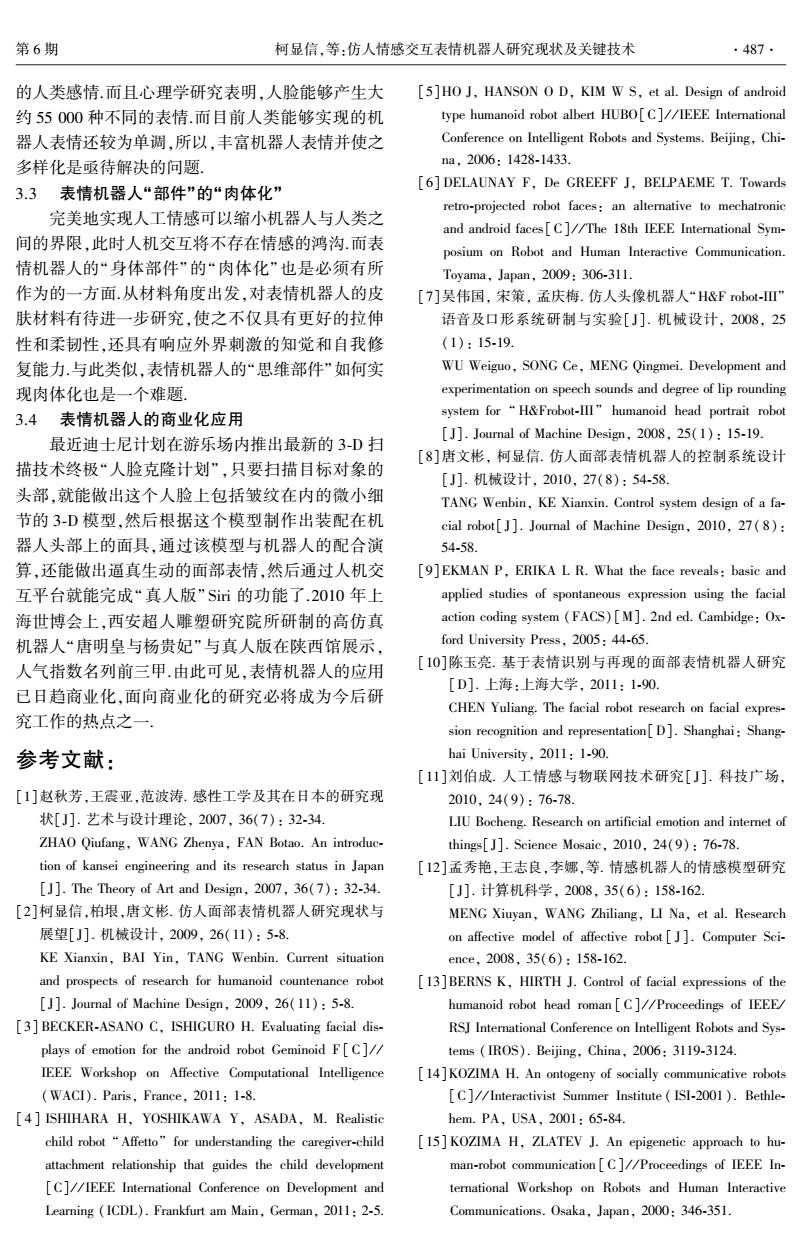正在加载图片...

第6期 柯显信,等:仿人情感交互表情机器人研究现状及关键技术 487· 的人类感情而且心理学研究表明,人脸能够产生大 [5]HO J,HANSON O D,KIM W S,et al.Design of android 约55000种不同的表情.而目前人类能够实现的机 type humanoid robot albert HUBO[C]//IEEE International 器人表情还较为单调,所以,丰富机器人表情并使之 Conference on Intelligent Robots and Systems.Beijing,Chi- 多样化是亟待解决的问题. na,2006:1428-1433. 3.3表情机器人“部件”的“肉体化” [6]DELAUNAY F,De GREEFF J,BELPAEME T.Towards retro-projected robot faces:an alternative to mechatronic 完美地实现人工情感可以缩小机器人与人类之 and android faces[C]//The 18th IEEE International Sym- 间的界限,此时人机交互将不存在情感的鸿沟.而表 posium on Robot and Human Interactive Communication. 情机器人的“身体部件”的“肉体化”也是必须有所 Toyama,Japan,2009:306-311. 作为的一方面.从材料角度出发,对表情机器人的皮 [7]吴伟国,宋策,孟庆梅.仿人头像机器人“H&Fbot-” 肤材料有待进一步研究,使之不仅具有更好的拉伸 语音及口形系统研制与实验[J].机械设计,2008,25 性和柔韧性,还具有响应外界刺激的知觉和自我修 (1):15-19. 复能力.与此类似,表情机器人的“思维部件”如何实 WU Weiguo,SONG Ce,MENG Qingmei.Development and 现肉体化也是一个难题, experimentation on speech sounds and degree of lip rounding 3.4表情机器人的商业化应用 system for“H&Frobot-lΠ”humanoid head portrait robot 最近迪士尼计划在游乐场内推出最新的3-D扫 [J].Journal of Machine Design,2008,25(1):15-19. [8]唐文彬,柯显信.仿人面部表情机器人的控制系统设计 描技术终极“人脸克隆计划”,只要扫描目标对象的 [J].机械设计,2010,27(8)54-58. 头部,就能做出这个人脸上包括皱纹在内的微小细 TANG Wenbin,KE Xianxin.Control system design of a fa- 节的3-D模型,然后根据这个模型制作出装配在机 cial robot J.Journal of Machine Design,2010,27(8): 器人头部上的面具,通过该模型与机器人的配合演 54-58. 算,还能做出逼真生动的面部表情,然后通过人机交 [9]EKMAN P,ERIKA L R.What the face reveals:basic and 互平台就能完成“真人版”Sii的功能了.2010年上 applied studies of spontaneous expression using the facial 海世博会上,西安超人雕塑研究院所研制的高仿真 action coding system (FACS)[M].2nd ed.Cambidge:Ox- 机器人“唐明皇与杨贵妃”与真人版在陕西馆展示, ford University Press,2005:44-65. 人气指数名列前三甲.由此可见,表情机器人的应用 [10]陈玉亮.基于表情识别与再现的面部表情机器人研究 [D].上海:上海大学,2011:1-90. 已日趋商业化,面向商业化的研究必将成为今后研 CHEN Yuliang.The facial robot research on facial expres- 究工作的热点之一 sion recognition and representation[D].Shanghai:Shang- 参考文献: hai University,2011:1-90. [11]刘伯成.人工情感与物联网技术研究[J].科技广场, [1]赵秋芳,王震亚,范波涛.感性工学及其在日本的研究现 2010.24(9):76-78. 状[J].艺术与设计理论,2007,36(7):32-34. LIU Bocheng.Research on artificial emotion and internet of ZHAO Qiufang,WANG Zhenya,FAN Botao.An introduc- things[J].Science Mosaic,2010,24(9):76-78. tion of kansei engineering and its research status in Japan [12]孟秀艳,王志良,李娜,等.情感机器人的情感模型研究 [J].The Theory of Art and Design,2007,36(7):32-34. [J].计算机科学,2008,35(6):158-162. [2]柯显信,柏垠,唐文彬.仿人面部表情机器人研究现状与 MENG Xiuyan,WANG Zhiliang,LI Na,et al.Research 展望[J].机械设计,2009,26(11):5-8. on affective model of affective robot[J.Computer Sci- KE Xianxin,BAI Yin,TANG Wenbin.Current situation ence,2008,35(6):158-162. and prospects of research for humanoid countenance robot [13]BERNS K,HIRTH J.Control of facial expressions of the [J].Journal of Machine Design,2009,26(11):5-8. humanoid robot head roman [C]//Proceedings of IEEE [3]BECKER-ASANO C,ISHIGURO H.Evaluating facial dis- RSJ International Conference on Intelligent Robots and Sys- plays of emotion for the android robot Geminoid F[C]/ tems (IROS).Beijing,China,2006:3119-3124. IEEE Workshop on Affective Computational Intelligence [14]KOZIMA H.An ontogeny of socially communicative robots (WACI).Paris,France,2011:1-8. [C]//Interactivist Summer Institute ISI-2001).Bethle- [4 ISHIHARA H,YOSHIKAWA Y,ASADA,M.Realistic hem.PA,USA,2001:65-84. child robot "Affetto"for understanding the caregiver-child [15]KOZIMA H,ZLATEV J.An epigenetic approach to hu- attachment relationship that guides the child development man-robot communication [C]//Proceedings of IEEE In- [C]//IEEE International Conference on Development and ternational Workshop on Robots and Human Interactive Learning (ICDL).Frankfurt am Main,German,2011:2-5. Communications.Osaka,Japan,2000:346-351.的人类感情.而且心理学研究表明,人脸能够产生大 约 55 000 种不同的表情.而目前人类能够实现的机 器人表情还较为单调,所以,丰富机器人表情并使之 多样化是亟待解决的问题. 3.3 表情机器人“部件”的“肉体化” 完美地实现人工情感可以缩小机器人与人类之 间的界限,此时人机交互将不存在情感的鸿沟.而表 情机器人的“身体部件”的“肉体化”也是必须有所 作为的一方面.从材料角度出发,对表情机器人的皮 肤材料有待进一步研究,使之不仅具有更好的拉伸 性和柔韧性,还具有响应外界刺激的知觉和自我修 复能力.与此类似,表情机器人的“思维部件”如何实 现肉体化也是一个难题. 3.4 表情机器人的商业化应用 最近迪士尼计划在游乐场内推出最新的 3⁃D 扫 描技术终极“人脸克隆计划”,只要扫描目标对象的 头部,就能做出这个人脸上包括皱纹在内的微小细 节的 3⁃D 模型,然后根据这个模型制作出装配在机 器人头部上的面具,通过该模型与机器人的配合演 算,还能做出逼真生动的面部表情,然后通过人机交 互平台就能完成“真人版” Siri 的功能了.2010 年上 海世博会上,西安超人雕塑研究院所研制的高仿真 机器人“唐明皇与杨贵妃”与真人版在陕西馆展示, 人气指数名列前三甲.由此可见,表情机器人的应用 已日趋商业化,面向商业化的研究必将成为今后研 究工作的热点之一. 参考文献: [1]赵秋芳,王震亚,范波涛. 感性工学及其在日本的研究现 状[J]. 艺术与设计理论, 2007, 36(7): 32⁃34. ZHAO Qiufang, WANG Zhenya, FAN Botao. An introduc⁃ tion of kansei engineering and its research status in Japan [J]. The Theory of Art and Design, 2007, 36(7): 32⁃34. [2]柯显信,柏垠,唐文彬. 仿人面部表情机器人研究现状与 展望[J]. 机械设计, 2009, 26(11): 5⁃8. KE Xianxin, BAI Yin, TANG Wenbin. Current situation and prospects of research for humanoid countenance robot [J]. Journal of Machine Design, 2009, 26(11): 5⁃8. [3] BECKER⁃ASANO C, ISHIGURO H. Evaluating facial dis⁃ plays of emotion for the android robot Geminoid F [ C] / / IEEE Workshop on Affective Computational Intelligence (WACI). Paris, France, 2011: 1⁃8. [ 4 ] ISHIHARA H, YOSHIKAWA Y, ASADA, M. Realistic child robot “Affetto” for understanding the caregiver⁃child attachment relationship that guides the child development [C] / / IEEE International Conference on Development and Learning (ICDL). Frankfurt am Main, German, 2011: 2⁃5. [5]HO J, HANSON O D, KIM W S, et al. Design of android type humanoid robot albert HUBO[C] / / IEEE International Conference on Intelligent Robots and Systems. Beijing, Chi⁃ na, 2006: 1428⁃1433. [6] DELAUNAY F, De GREEFF J, BELPAEME T. Towards retro⁃projected robot faces: an alternative to mechatronic and android faces[C] / / The 18th IEEE International Sym⁃ posium on Robot and Human Interactive Communication. Toyama, Japan, 2009: 306⁃311. [7]吴伟国, 宋策, 孟庆梅. 仿人头像机器人“H&F robot⁃III” 语音及口形系统研制与实验[ J]. 机械设计, 2008, 25 (1): 15⁃19. WU Weiguo, SONG Ce, MENG Qingmei. Development and experimentation on speech sounds and degree of lip rounding system for “ H&Frobot⁃III” humanoid head portrait robot [J]. Journal of Machine Design, 2008, 25(1): 15⁃19. [8]唐文彬, 柯显信. 仿人面部表情机器人的控制系统设计 [J]. 机械设计, 2010, 27(8): 54⁃58. TANG Wenbin, KE Xianxin. Control system design of a fa⁃ cial robot[ J]. Journal of Machine Design, 2010, 27( 8): 54⁃58. [9]EKMAN P, ERIKA L R. What the face reveals: basic and applied studies of spontaneous expression using the facial action coding system (FACS)[M]. 2nd ed. Cambidge: Ox⁃ ford University Press, 2005: 44⁃65. [10]陈玉亮. 基于表情识别与再现的面部表情机器人研究 [D]. 上海:上海大学, 2011: 1⁃90. CHEN Yuliang. The facial robot research on facial expres⁃ sion recognition and representation[D]. Shanghai: Shang⁃ hai University, 2011: 1⁃90. [11]刘伯成. 人工情感与物联网技术研究[ J]. 科技广场, 2010, 24(9): 76⁃78. LIU Bocheng. Research on artificial emotion and internet of things[J]. Science Mosaic, 2010, 24(9): 76⁃78. [12]孟秀艳,王志良,李娜,等. 情感机器人的情感模型研究 [J]. 计算机科学, 2008, 35(6): 158⁃162. MENG Xiuyan, WANG Zhiliang, LI Na, et al. Research on affective model of affective robot [ J]. Computer Sci⁃ ence, 2008, 35(6): 158⁃162. [13]BERNS K, HIRTH J. Control of facial expressions of the humanoid robot head roman [ C] / / Proceedings of IEEE/ RSJ International Conference on Intelligent Robots and Sys⁃ tems (IROS). Beijing, China, 2006: 3119⁃3124. [14]KOZIMA H. An ontogeny of socially communicative robots [C] / / Interactivist Summer Institute ( ISI⁃2001). Bethle⁃ hem. PA, USA, 2001: 65⁃84. [15] KOZIMA H, ZLATEV J. An epigenetic approach to hu⁃ man⁃robot communication [ C] / / Proceedings of IEEE In⁃ ternational Workshop on Robots and Human Interactive Communications. Osaka, Japan, 2000: 346⁃351. 第 6 期 柯显信,等:仿人情感交互表情机器人研究现状及关键技术 ·487·